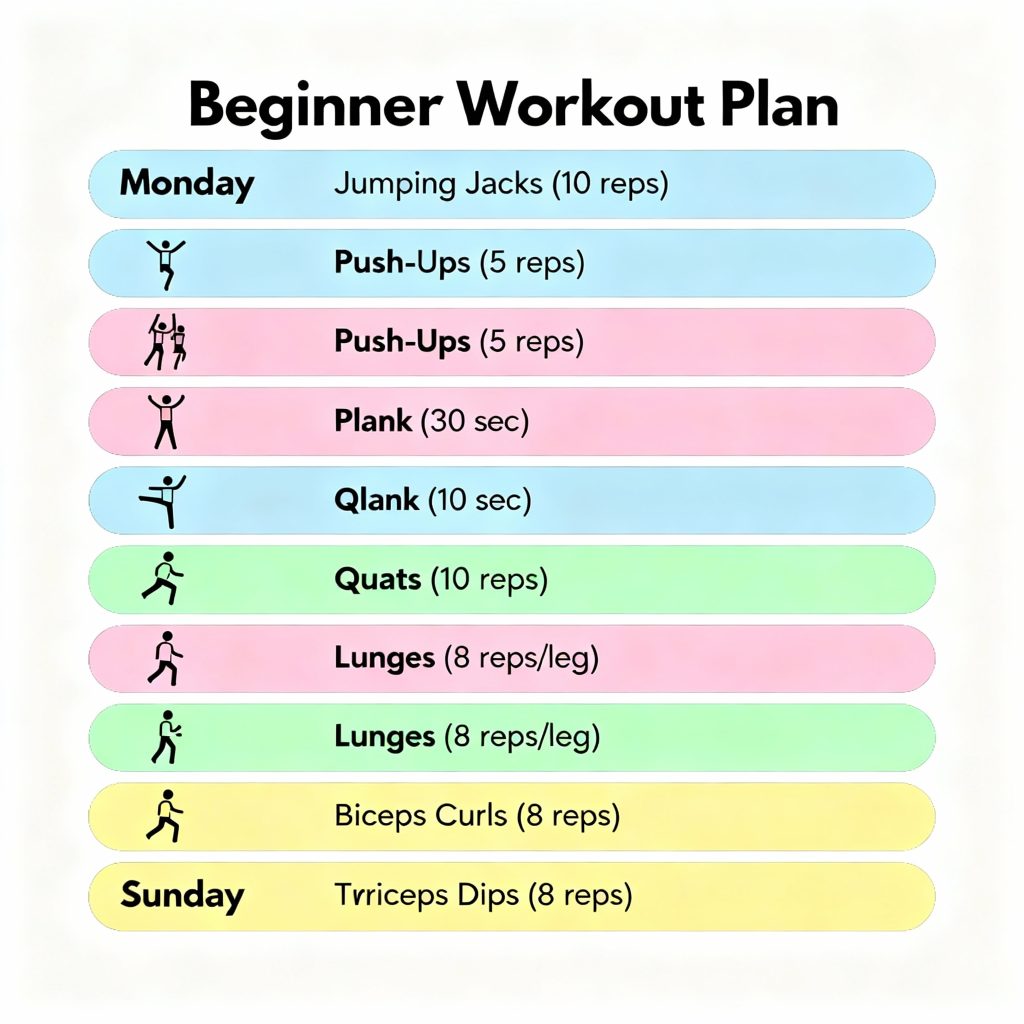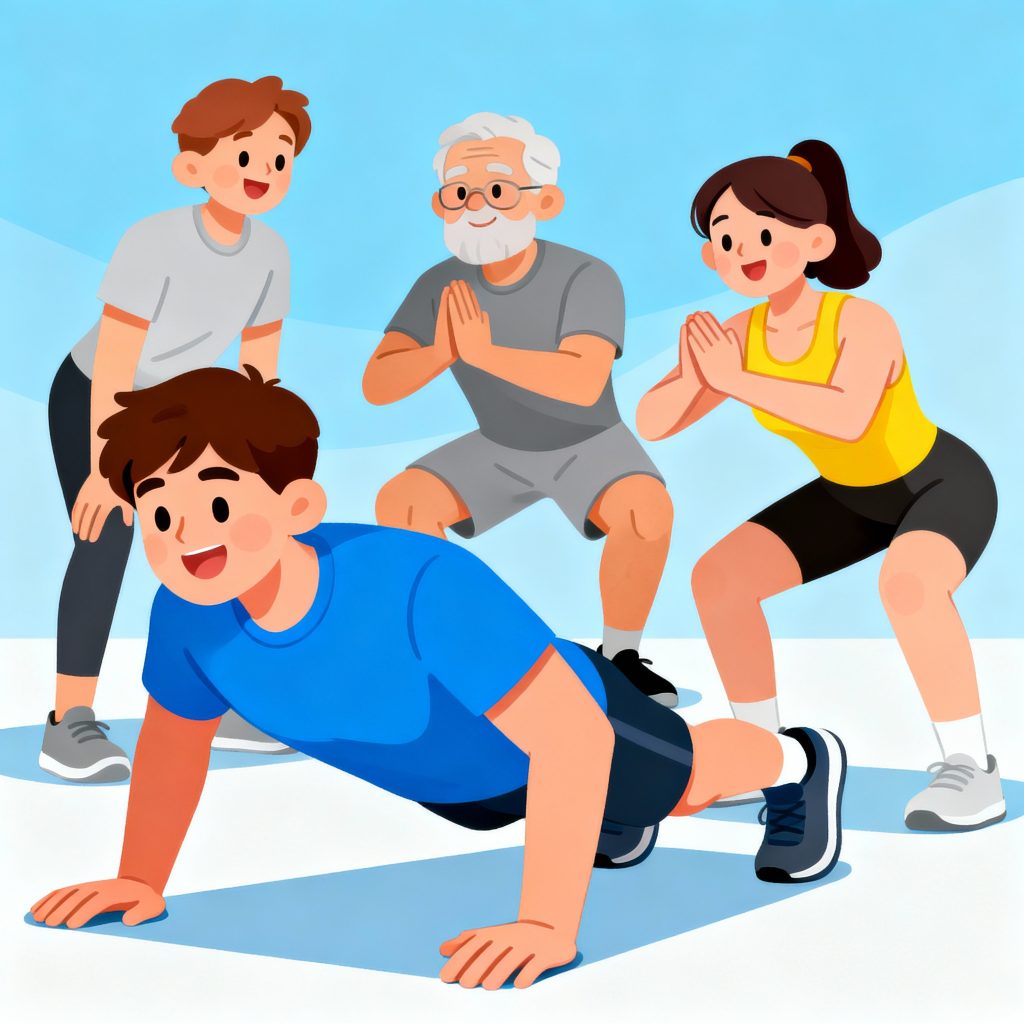Are you tired of feeling overwhelmed by complicated fitness routines and intimidating gym equipment? You’re not alone – over 73% of people who start a workout plan for beginners quit within the first three months due to unrealistic expectations and poor planning. The good news is that starting your fitness journey doesn’t require expensive equipment or years of experience. With the right beginner-friendly approach, you can build sustainable habits that will transform your health and confidence.
Why Starting with a Structured Workout Plan Matters
Beginning your fitness journey without a proper workout plan for beginners is like trying to build a house without blueprints. Research shows that people who follow structured exercise routines are 42% more likely to maintain their fitness habits long-term compared to those who wing it.
The current fitness landscape has evolved significantly, especially post-2024. Home workouts have become mainstream, with hybrid fitness approaches combining gym sessions and at-home routines gaining popularity. This flexibility makes it easier than ever for beginners to start their fitness journey without the pressure of crowded gyms or expensive memberships.
Your body needs time to adapt to new physical demands. A well-designed beginner exercise routine gradually increases intensity, allowing your muscles, joints, and cardiovascular system to strengthen safely. This progressive approach prevents injuries that could derail your progress and keeps you motivated as you see consistent improvements.
Essential Components of an Effective Beginner Fitness Program
Cardiovascular Training Foundation
Cardio workouts for beginners should focus on low-impact activities that build endurance without overwhelming your system. Walking remains the most accessible starting point – it requires no equipment, can be done anywhere, and provides excellent health benefits when performed consistently.
Start with 15-20 minutes of brisk walking three times per week. As your stamina improves, gradually increase duration by five minutes weekly until you reach 30-45 minutes per session. Other beginner-friendly cardio options include stationary cycling, swimming, or following online dance workout videos.
The key is consistency over intensity. Your heart rate should allow you to maintain a conversation while exercising – this indicates you’re working in the optimal zone for building cardiovascular fitness without overexertion.
Strength Training Fundamentals
Strength training for beginners doesn’t require a gym membership or heavy weights. Bodyweight exercises provide an excellent foundation for building muscle strength and improving functional movement patterns. These exercises use your own body weight as resistance, making them perfect for home workouts.
Focus on compound movements that work multiple muscle groups simultaneously. Push-ups target your chest, shoulders, and triceps while engaging your core. Squats strengthen your legs, glutes, and lower back. Planks build core stability that supports all other movements.
Start with 2-3 strength training sessions per week, allowing at least one day of rest between sessions for muscle recovery. Begin with 8-12 repetitions of each exercise, completing 1-2 sets initially. As you grow stronger, gradually increase to 3 sets of 12-15 repetitions.
Your 4-Week Progressive Workout Schedule
Week 1-2: Foundation Building
Monday, Wednesday, Friday:
-
5-minute warm-up walk
-
Bodyweight squats: 2 sets of 8-10 reps
-
Modified push-ups (knee or wall): 2 sets of 5-8 reps
-
Plank hold: 2 sets of 15-20 seconds
-
Standing marches: 2 sets of 10 each leg
-
10-minute cool-down walk
Tuesday, Thursday:
-
15-20 minutes brisk walking or light cycling
-
Basic stretching routine (10 minutes)
Weekend:
-
One active rest day with gentle stretching
-
One complete rest day
Week 3-4: Progression Phase
Monday, Wednesday, Friday:
-
5-minute dynamic warm-up
-
Bodyweight squats: 3 sets of 10-12 reps
-
Push-ups (progress toward full if possible): 2-3 sets of 6-10 reps
-
Plank hold: 3 sets of 20-30 seconds
-
Lunges (alternating legs): 2 sets of 8 each leg
-
Glute bridges: 2 sets of 10-12 reps
-
10-minute cool-down walk
Tuesday, Thursday:
-
20-25 minutes moderate cardio
-
Extended stretching routine (15 minutes)
This beginner fitness program gradually introduces new movements while allowing your body to adapt safely. The progressive nature ensures you’re constantly challenged without overwhelming your system.
Nutrition Tips to Support Your Workout Plan
Proper nutrition amplifies the benefits of your workout plan for beginners. You don’t need complicated meal plans or expensive supplements – focus on consistent, balanced eating habits that fuel your workouts and support recovery.
Eat a small snack containing carbohydrates and protein 30-60 minutes before exercising. A banana with peanut butter or Greek yogurt with berries provides sustained energy without causing digestive discomfort during your workout.
Post-workout nutrition is crucial for recovery. Within two hours of exercising, consume a meal or snack that includes protein to repair muscles and carbohydrates to replenish energy stores. Chocolate milk, a protein smoothie, or a turkey sandwich are excellent options.
Stay hydrated throughout the day, not just during workouts. Proper hydration supports every bodily function, including muscle recovery and energy production. Aim for 8-10 glasses of water daily, increasing intake on workout days.
Common Mistakes to Avoid as a Fitness Beginner
Many beginners sabotage their progress by doing too much too soon. Your enthusiasm is admirable, but your body needs time to adapt to new physical demands. Attempting advanced exercises or working out daily from day one often leads to burnout, injury, or both.
Skipping warm-ups and cool-downs is another costly mistake. These components prepare your body for exercise and aid in recovery. Spend 5-10 minutes warming up with light movement and stretching afterward to maintain flexibility and reduce soreness.
Comparing your progress to others on social media creates unrealistic expectations. Everyone’s fitness journey is unique, influenced by genetics, starting fitness level, and lifestyle factors. Focus on your own improvements and celebrate small victories along the way.
Neglecting rest days undermines your progress. Muscles grow and strengthen during recovery periods, not during workouts themselves. Schedule rest days into your routine and honor them – they’re as important as your training days.

Tracking Progress and Staying Motivated
Measuring progress extends beyond the scale. Take body measurements, progress photos, and note improvements in strength and endurance. Can you hold a plank longer this week than last? Are you less winded after climbing stairs? These victories matter more than weight fluctuations.
Keep a simple workout log tracking exercises performed, repetitions completed, and how you felt during each session. This record helps you see patterns, identify what works best for your body, and maintain consistency even when motivation wanes.
Set realistic, specific goals that extend beyond appearance changes. Aim to complete your first full push-up, walk a certain distance without stopping, or exercise consistently for four weeks. Achievement-based goals provide clear targets and boost confidence as you reach them.
Find an accountability partner or join online communities of fellow beginners. Sharing your journey, challenges, and successes creates support systems that sustain long-term commitment to your fitness goals.
Adapting Your Routine for Long-Term Success
As you complete your first month of consistent exercise, your body will be ready for new challenges. The beauty of a well-designed workout plan for beginners is its scalability – each exercise can be modified to increase difficulty as you grow stronger.
Progress your bodyweight exercises by increasing repetitions, adding more challenging variations, or incorporating light weights when available. Push-ups can evolve from wall or knee versions to full push-ups, then to decline or one-arm variations.
Listen to your body’s signals and adjust accordingly. Some days you’ll feel energetic and ready to push harder; others may require lighter activity or additional rest. Flexibility in your approach prevents rigid thinking that often leads to all-or-nothing mentalities.
Consider exploring new activities that complement your foundation routine. Group fitness classes, hiking, swimming, or recreational sports can add variety while building upon the fitness base you’ve established. The goal is creating a lifestyle that includes regular physical activity, not just completing a temporary program.
Frequently Asked Questions
How often should beginners exercise each week?
Beginners should aim for 3-5 exercise sessions per week, including both cardio and strength training. Start with 3 sessions weekly and gradually increase frequency as your fitness improves. Always include at least one complete rest day to allow for proper recovery.
What equipment do I need for a beginner workout plan?
You need minimal equipment to start an effective workout plan for beginners. A yoga mat for floor exercises, comfortable athletic shoes, and workout clothes are sufficient. As you progress, resistance bands or light dumbbells can add variety, but bodyweight exercises provide excellent results initially.
How long should each workout session last?
Beginner workout sessions should last 20-45 minutes, including warm-up and cool-down periods. Quality matters more than duration – a focused 30-minute session with proper form is more beneficial than a rushed hour-long workout with poor technique.
When will I start seeing results from my workout routine?
Most beginners notice improved energy levels and better sleep within 1-2 weeks of consistent exercise. Visible physical changes typically appear after 4-6 weeks, while significant strength and endurance improvements develop over 6-12 weeks of regular training.
What should I do if I miss a workout day?
Missing occasional workouts is normal and won’t derail your progress. Simply resume your routine the next scheduled day without trying to “make up” missed sessions. Consistency over time matters more than perfect adherence – aim for 80% consistency rather than perfection.
Ready to transform your health and build lasting fitness habits? Start with day one of this proven workout plan for beginners today. Remember, every fitness expert was once a beginner who decided to take that crucial first step. Your future self will thank you for starting now rather than waiting for the “perfect” time. Download a fitness tracking app, schedule your first workout session, and begin your journey toward a stronger, healthier you!











